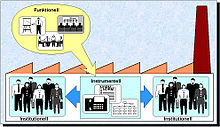Organization (economy)
Organization deals with the assignment of tasks, rights and obligations to job holders in work and action systems and is characterized by rules with a structural effect. It arose in business administration from the dual problem in which differentiation (differentiation of tasks; division of labor → striving apart) and integration (cohesion) had to be agreed.
The term organization can be used in different ways (picture connection of organizational terms):
- Functional: Organization as a function, i.e. the creation of rules and structures
- Instrumental: Organization as an instrument, such as rules, structures (hierarchies)
- Institutional: Organization as an institution, i.e. as a system (such as a company, an authority, an association ...)
The organizational tasks are performed by the organizers or by the organizational department and the head of the organizational unit.
Company processes and organizational structure
Processes in the company are controlled via the structure ( organizational structure ), process regulations ( process organization ) and self-organization (informal organization). The organizational culture can be the binding framework for operational organization in which informal processes can compensate for possible deficiencies in the formal structure. Grown historically, the corporate culture forms a "connective tissue" to link the elements that were separated in the course of the division of labor.
The organizational structure forms the hierarchical framework of an organization (e.g. an authority or a company). It defines which tasks have to be mastered by which people and material resources.
Main article: organizational structure
Organizational forms
The following forms of primary organization can be distinguished on the basis of the type and scope of the specialization of positions (functional and object-oriented), on the basis of the subordinate relationships (single or multiple subordination) and on the basis of the authorizations (full competencies, partial competencies):
- Single line system
- Multi-line system
- Staff line organization
- Functional organization
- Divisional organization
- Matrix organization
- Tensor organization
- Holding organization
- Network organization
- Modular organization
- Virtual organization
The following forms of secondary organization that complement the primary organization can be distinguished:
- Project organization
- Staff principle
- Matrix principle
- Spin-off principle
- Working group principle
Process organization
The process organization is to record regulations of processes and sequences and analyze processes in the process. One of their main tasks is to shorten processes by e.g. B. processes are canceled, times are reduced or parallel processing is introduced.
The process organization is usually faced with the problem of whether greater emphasis should be placed on continuity or lower costs in the production process. For example, several production systems allow a more flexible response and continuous flow, while the fixed costs are correspondingly high. In contrast, this cost could be reduced by using less manufacturing equipment. However, the throughput and idle times will increase.
Representations and documents
Organizational structures can be represented as follows:
- graphically
- tabular
- verbal
- mathematically
Important documentation options can e.g. B. Organizational charts , communication diagrams or sociograms . For a clear identification of functions and for the conceptual division of tasks, job descriptions are necessary that define the integration of a position into the organizational structure.
Organizational development
Nowadays, the TQM system (Total Quality Management) has established itself, through which a continuous process of change is aimed for. In TQM, value is placed on self-organization and thus also on self-discipline on the part of the employee.
See also: business process , quality management , organizational department , organizational controlling
Organization in the field of organizational behavior
According to the interdisciplinary field of organizational behavior , marketable organizations essentially consist of the communication of and about decisions. Each individual decision builds on previous decisions and is itself a prerequisite for subsequent decisions. In view of the effective reciprocal references of the decisions to other decisions, a recursive decision network results, whose self-reflection takes place on the basis of internal decision-oriented communication processes.
literature
- Michael Berger, Jutta Chalupsky, Frank Hartmann: Change Management - (Sur) life in organizations . 7th edition. Publishing house Dr. Götz Schmidt, Gießen 2013, ISBN 978-3-921313-88-6 .
- Fritz Gairing: Organizational development as a learning process for people and systems. Weinheim 2008.
- Rainer Marr , Martin Elbe : Organization . In: Gabler Lexikon Technologiemanagement. Management of innovations and new technologies in the company . Edited by Dieter Specht & Martin G. Möhrle, Gabler, Wiesbaden 2002, ISBN 3-409-11822-5 , pp. 198-201
- Edgar Schein: Process consulting for the organization of the future. Cologne 2000, ISBN 3-897-97010-4 .
- Georg Schreyögg: Organization . Basics of modern organizational design. With case studies. 8th edition. Gabler Verlag, Wiesbaden 2008, ISBN 3-8349-0703-0 .
Individual evidence
- ^ Henry Mintzberg (2002) Strategy Safari. A journey through the wilderness of strategic management ; Frankfurt / Vienna: page 300.
